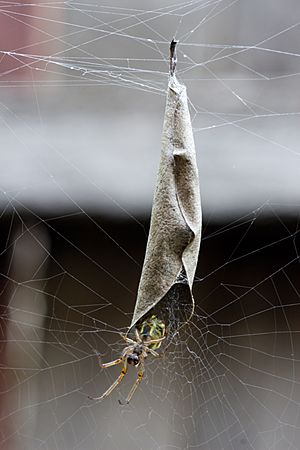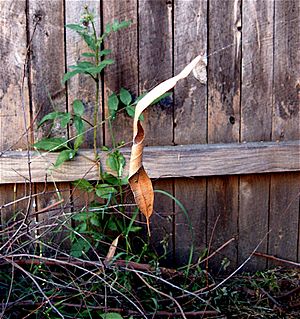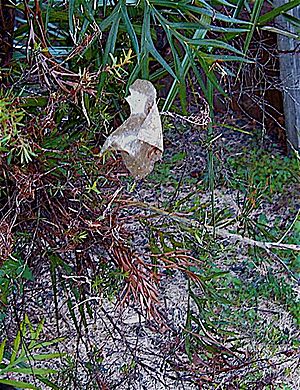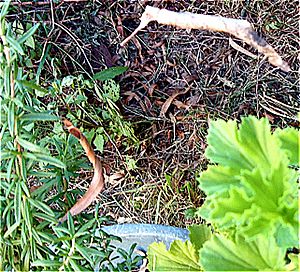Phonognatha graeffei facts for kids
Quick facts for kids Phonognatha graeffei |
|
|---|---|
 |
|
| Scientific classification | |
| Genus: |
Phonognatha
|
| Species: |
graeffei
|
The Phonognatha graeffei, also known as the leaf curling spider, is a common Australian spider. You can find it in woodlands and city areas across the northeastern, eastern, and southern parts of Australia. This small spider belongs to the family Araneidae, which are known for building round, wheel-shaped webs. It used to be grouped with a different family called Tetragnathidae.
This spider is special because it uses a curled leaf right in the middle of its web. This leaf acts like a cozy shelter. Sometimes, a male and female spider might even share the same leaf, living at opposite ends. When it's time for the female to lay eggs, she makes a separate curled leaf "nursery" nearby.
Contents
What Does the Leaf Curling Spider Look Like?
Male leaf curling spiders are about 5 to 6 millimeters long. Females are a bit bigger, measuring 8 to 12 millimeters. Both males and females look quite similar. They have reddish-brown legs and bodies. Their backs have a cool cream-colored pattern. Their bodies are round and oval-shaped, and their legs are long and slender.
The Spider's Amazing Web Home
The leaf curling spider's web is easy to spot because of its unique shelter in the middle. This clever spider weaves a leaf or another small object into the center of its web. This acts as a perfect hiding spot from birds and other animals that might want to eat it.
The spider twists a leaf along its length to create a funnel shape. If needed, it might even add a silk wall on one side to make it more secure. These spiders are resourceful! They have also been seen using old snail shells or even discarded pieces of paper for their homes. Even though many spiders might live in the same general area, each spider builds its own web.
A leaf curling spider's web is usually about 30 centimeters wide. It's not a full circle; it's open at the top and fans out downwards. The spider uses strong silk threads to hang its curled-up dry leaf from a nearby plant. The main part of the web spreads out like a fan from this leaf home. The spider hides inside its leaf, with only the tips of its legs showing. It uses these legs to feel for vibrations from insects that get caught in the web. The spider only comes out of its shelter if an insect is caught or if its web needs fixing. These spiders usually rebuild their webs at night.
How Leaf Curling Spiders Live
Leaf curling spiders are active during the day. They protect themselves from predators by staying inside their silk-lined, curled leaf homes. For the P. graeffei spider, this leaf is usually just above the center of its web. However, in other types of leaf curling spiders, the leaf might be placed higher up. Some leaves might already be a bit curled, but many are not. The spider pulls and spins silk to turn the leaf into a cylinder-shaped hideaway. It seals the top with silk, but leaves the bottom open where it connects to the web. Like other web-building spiders, they mostly eat flying insects. They can even catch insects bigger than themselves!
These spiders are known for something special: the male and female often live together. They share the same curled leaf home, staying at opposite ends. The female usually stays at the open end of the leaf.
Spider Life Cycle and Mating
It's quite unusual for orb-weaving spiders, but male leaf curling spiders often live with females, even if the females are not yet fully grown. The male will mate with the female soon after she sheds her skin for the last time. Male spiders might live close by, or even in the same web as the female. Mating happens once the female has her final molt.
Scientists believe that males living with females might be a way for them to "guard" their mate. This means that male spiders living in a leaf home will chase away other male spiders that try to come onto the web. This behavior seems to depend on whether the female is ready to have babies. Males protecting younger females tend to be more aggressive than those protecting adult females who haven't mated yet.
Sometimes, a female spider might eat the male spider she lives with. This can happen whether or not the female has had enough food. Interestingly, females who eat a male spider don't seem to have more babies than females who don't.
When the female is ready to lay her eggs, she creates a special egg sac. She places this sac inside a dead leaf that she bends over and seals with silk. This egg sac is then hung among other leaves, away from her main web.
Baby Spiders (Spiderlings)
When they are very young, baby spiders start by bending a small green leaf to make their first tiny home. As they grow bigger, they move on to larger dead leaves or other light objects. They use silk lines to pull these up from the ground at night to create their new shelters.
Where Do Leaf Curling Spiders Live?
You can commonly find the leaf curling spider in open woodlands and forests. They also live in gardens in cities and suburbs across the northeastern, eastern, and southern states of Australia.
Leaf Curling Spiders and People
The leaf curling spider has small fangs that move sideways. It's a shy spider and doesn't usually bite humans. It's extremely rare for these spiders to bite people, so we don't know much about how their venom affects humans. If a bite were to happen, it might cause a small reaction like pain and swelling in that area. However, these bites are not considered dangerous.




